

Why The Human Body Will Be The Next Computer Interface. Tactus Technology. Build Your Own Google Glass. Last April, Google announced Project Glass.
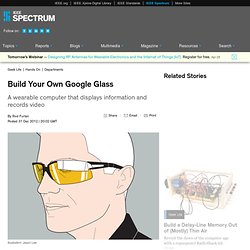
Its goal is to build a wearable computer that records your perspective of the world and unobtrusively delivers information to you through a head-up display. With Glass, not only might I share fleeting moments with the people I love, I’d eventually be able to search my external visual memory to find my misplaced car keys. Sadly, there is no release date yet. A developer edition is planned for early this year at the disagreeable price of US $1500, for what is probably going to be an unfinished product.
The final version isn’t due until 2014 at the earliest [see “Google Gets in Your Face,” in this issue]. Augmented Reality Products & Solutions. Location-Based Services. Kovio. Thinfilm to deliver NFC-readable sensor labels in 2014; Sensing, memory, and RF communication, all in a single label for < $1.
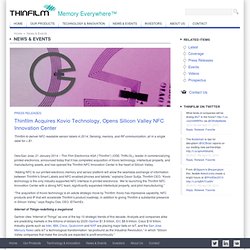
Oslo/San Jose, 21 January 2014 – Thin Film Electronics ASA (“Thinfilm”) (OSE: THIN.OL), leader in commercializing printed electronics, announced today that it has completed acquisition of Kovio technology, intellectual property, and manufacturing assets, and has opened the Thinfilm NFC Innovation Center in the heart of Silicon Valley. “Adding NFC to our printed electronic memory and sensor platform will allow the seamless exchange of information between Thinfilm’s Smart Labels and NFC-enabled phones and tablets.” explains Davor Sutija, Thinfilm CEO. LTU. * The Sensors Are Coming! ST MicroelectronicsA microscopic view of a gyroscope sensor created by STMicroelectronics.
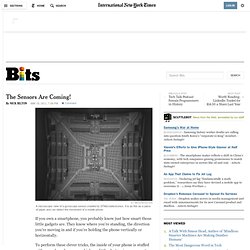
It is as thin as a piece of paper and can detect the movement of a mobile phone. If you own a smartphone, you probably know just how smart those little gadgets are. They know where you’re standing, the direction you’re moving in and if you’re holding the phone vertically or horizontally. To perform these clever tricks, the inside of your phone is stuffed with a number of sensors, which are little electronic components that can sometimes be as thin as a piece of paper.
The coming generation of mobile phones — and other gadgets for that matter — will have so many new types of smart sensors that your current mobile phone will look pretty dumb. LabCAST - The MIT Media Lab Video Podcast » Archive » #52 Junkyard Jumbotron. Amazing Google Glasses Demonstration at Google I/O 2012. Senseg. Mobile Device Insight » Sensors in Smartphones » Mobile Device Insight. A Survey of Mobile Phone Sensing. Location, Context, and Mobile Services - The Vision. Rush: repeated recommendations on mobile devices (Sebastian Boring) We partially provoked occlusion and were able to measureits effects on performance.We measured task time and error rates for each trial.
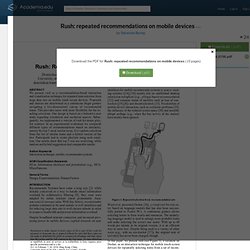
Thetask time began as soon as the participant put a finger onthe screen and ended when the last item was selected. A Mind-Blowing UI That Could Finally Make Group Work Intuitive. We’ve seen "magic-window" augmented reality interfaces, Minority Report-style gestural interfaces, and computer-vision-powered collaborative display interfaces.
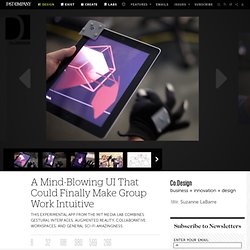
But what about an iPad app that combines all three? That would be T(ether), an experimental design from the MIT Media Lab. Creators Matthew Blackshaw, Dávid Lakatos, Hiroshi Ishii, and Ken Perlin call T(ether) "a tool for spatial expression" that "acts as a window affording users a perspective view of three-dimensional data through tracking of head position and orientation. " In English, that means you can hold the iPad up with one hand to reveal a shared virtual space that you can manipulate with the other hand using a special glove. T(ether) opens up mind-boggling possibilities for creating interactive digital art or exploring novel scientific visualizations.
Cyborg America: inside the strange new world of basement body hackers. Shawn Sarver took a deep breath and stared at the bottle of Listerine on the counter.

“A minty fresh feeling for your mouth... cures bad breath,” he repeated to himself, as the scalpel sliced open his ring finger. His left arm was stretched out on the operating table, his sleeve rolled up past the elbow, revealing his first tattoo, the Air Force insignia he got at age 18, a few weeks after graduating from high school. MirageBlocks. Wockets: Open Source Accelerometers for Phones. Sensors and Software for Real-Time Activity Recognition on Mobile Phones The goal of this open source project is to create software and hardware that permits automatic, 24/7 physical activity and context detection on common mobile phones.

We are doing this by iteratively designing and testing Wockets -- miniature, low-cost hardware devices that will measure human motion using accelerometers. The "mega trend" that swallowed Silicon Valley. By Jennifer Alsever, contributor FORTUNE -- It's 8 a.m. on a Thursday, and a message pops up on Nancy Tcheou's iPhone.
It shows a map of downtown San Francisco with the exact location of a guy she's never met named Zach Lagod. * The Most Important New Technology Since the Smart Phone Arrives December 2012. By now, many of us are aware of the Leap Motion, a small, $70 gesture control system that simply plugs into any computer and, apparently, just works.
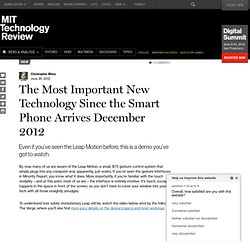
If you’ve seen the gesture interfaces in Minority Report, you know what it does.